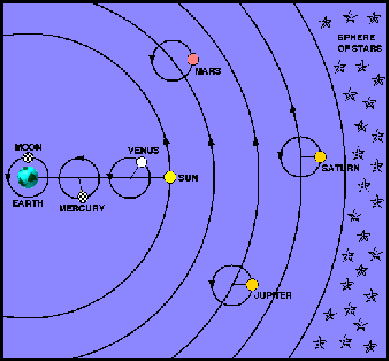
The active power of the sun’s essential nature is found to be heating and, to a certain degree, drying. This is made more easily perceptible in the case of the sun than any other heavenly body by its size and by the obviousness of its seasonal changes, for the closer it approaches to the zenith the more it affects us in this way. Most of the moon’s power consists of humidifying, dearly because it is close to the earth and because of the moist exhalations therefrom. Its action therefore is precisely this, to soften and cause putrefaction in bodies for the most part, but it shares moderately also in heating power because of the light which it receives from the sun.
It is Saturn’s quality chiefly to cool and [moist] rarely, to dry, probably because he is furthest removed both from the sun’s heat and the moist exhalations about the earth. Both in Saturn’s case and in that of the other planets there are powers, too, which arise through the observation of their aspects to the sun and the moon, for some of them appear to modify conditions in the ambient in one way, some in another, by increase or by decrease.
The nature of Mars is chiefly to dry and to burn, in conformity with his fiery colour and by reason of his nearness to the sun, for the sun’s sphere lies just below him.
Jupiter has a temperate active force because his movement takes place between the cooling influence of Saturn and the burning power of Mars. He both heats and humidifies; and because his heating power is the greater by reason of the underlying spheres, he produces fertilizing winds.
Venus has the same powers and tempered nature as Jupiter, but acts in the opposite way; for she warms moderately because of her nearness to the sun, but chiefly humidifies, like the moon, because of the amount of her own light and because she appropriates the exhalations from the moist atmosphere surrounding the earth.
Mercury in general is found at certain times alike to be drying and absorptive of moisture, because he never is far removed in longitude from the heat of the sun; and again humidifying, because he is next above the sphere of the moon, which is closest to the earth; and to change quickly from one to the other, inspired as it were by the speed of his motion in the neighbourhood of the sun itself.
 ⌕
⌕